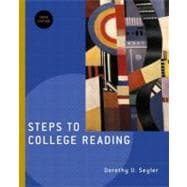
| Most chapters begin with Prepare to Read and conclude with Chapter Review Quiz | |
| Preface | |
| Getting Started | |
| Commit | |
| Concentrate | |
| Know about Reading | |
| Be an Active Reader | |
| How the Sun Came | |
| Tips for Staying Well | |
| Developing a Reading Strategy | |
| Prepare to Read | |
| Why Have a Reading Strategy? Prepare-Read-Respond: How the Steps Connect | |
| Prepare | |
| Read | |
| Respond | |
| Open Season: Children as Prey | |
| Hydrogen and the Hindenburg | |
| Word Power 1: Using Context Clues and Building Vocabulary | |
| Context Clues | |
| Learning New Words | |
| A Brief Book List | |
| Opposing Principles Help Balance Society | |
| Word Power 2: Recognizing Word Parts and Knowing Your Dictionary | |
| Compound Words | |
| Learning from Word Parts: Prefixes, Roots, and Suffixes | |
| Knowing Your Dictionary | |
| Pronunciation | |
| Abbreviations Used in Dictionary Entries | |
| Working with Word Meanings | |
| Defining English | |
| Distinguishing between General and Specific Statements | |
| General and Specific Statements | |
| Levels of Specificity | |
| Recognizing General and Specific Sentences | |
| Understanding Complicated Sentences | |
| In the Rain Forest | |
| Understanding Main Ideas | |
| Identifying a Paragraph's Topic | |
| Identifying Main Ideas | |
| Reading Longer Passages | |
| The Summary | |
| The Pyramids | |
| Recognizing Strategies and Structures in Writing | |
| Explaining by Listing | |
| Time Sequence and Process | |
| Definition | |
| Comparison and Contrast | |
| Cause and Effect | |
| Mixed Patterns | |
| Smoke and Mirrors | |
| Neat People vs. Sloppy People | |
| Reading Graphics | |
| How to Read Graphics | |
| Pictures and Photographs | |
| Diagrams | |
| Maps | |
| Tables | |
| Graphs and Charts | |
| Graphs Can Lie, Easy as Pie | |
| Reading and Studying for College Classes | |
| Reading Textbooks | |
| Writing-to-Learn Strategies | |
| Learning from Three Textbook Sections | |
| Reinforcing Learning in Class | |
| Preparing for Testing | |
| Reading More Efficiently | |
| Scanning | |
| Skimming | |
| Improving Visual Skills | |
| Improving Visual Skills through Improved Spelling | |
| Efficient Reading through Aggressive Reading | |
| Timed Reading I | |
| Some Principles of Communication | |
| Timed Reading II | |
| The Rude Awaken | |
| Timed Reading III: Lefton and Valvatne, Coping, Health, and a Positive Attitude | |
| Drawing Inferences and Understanding Implied Main Ideas | |
| What Are Inferences? Drawing Inferences from Reading | |
| Connotation | |
| Figurative Language | |
| Characteristics of Appropriate Inferences | |
| Understanding Implied Main Ideas | |
| Drawing Inferences and Understanding Implied Meanings in Longer Passages | |
| Table of Contents provided by Publisher. All Rights Reserved. |
The New copy of this book will include any supplemental materials advertised. Please check the title of the book to determine if it should include any access cards, study guides, lab manuals, CDs, etc.
The Used, Rental and eBook copies of this book are not guaranteed to include any supplemental materials. Typically, only the book itself is included. This is true even if the title states it includes any access cards, study guides, lab manuals, CDs, etc.